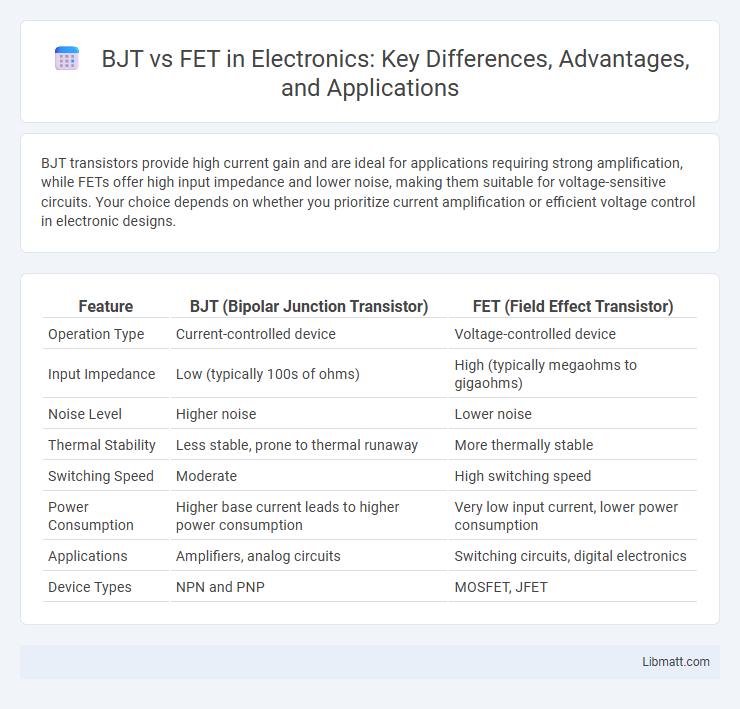BJT transistors provide high current gain and are ideal for applications requiring strong amplification, while FETs offer high input impedance and lower noise, making them suitable for voltage-sensitive circuits. Your choice depends on whether you prioritize current amplification or efficient voltage control in electronic designs.
Table of Comparison
| Feature | BJT (Bipolar Junction Transistor) | FET (Field Effect Transistor) |
|---|---|---|
| Operation Type | Current-controlled device | Voltage-controlled device |
| Input Impedance | Low (typically 100s of ohms) | High (typically megaohms to gigaohms) |
| Noise Level | Higher noise | Lower noise |
| Thermal Stability | Less stable, prone to thermal runaway | More thermally stable |
| Switching Speed | Moderate | High switching speed |
| Power Consumption | Higher base current leads to higher power consumption | Very low input current, lower power consumption |
| Applications | Amplifiers, analog circuits | Switching circuits, digital electronics |
| Device Types | NPN and PNP | MOSFET, JFET |
Introduction to BJT and FET
Bipolar Junction Transistors (BJTs) are current-controlled devices relying on charge carrier injection between emitter and collector regions, commonly used for amplification and switching. Field Effect Transistors (FETs) operate based on voltage control of the electric field affecting the conductivity of a semiconductor channel, characterized by high input impedance and low power consumption. Both BJTs and FETs play crucial roles in analog and digital circuits, each optimized for specific applications depending on their electrical properties.
Basic Structure and Operation
Bipolar Junction Transistors (BJTs) consist of three layers: emitter, base, and collector, operating through current control where a small base current modulates a larger collector current. Field-Effect Transistors (FETs) have a channel between source and drain controlled by voltage applied to the gate, enabling voltage-controlled operation with high input impedance. Your choice depends on whether current-driven (BJT) or voltage-driven (FET) control suits your application's performance requirements.
Key Differences in Working Principle
Bipolar Junction Transistors (BJT) operate based on current control, where a small base current controls a larger collector current through the device. Field-Effect Transistors (FET), on the other hand, function via voltage control, using an electric field generated by the gate terminal to regulate the current flow between the source and drain. Understanding these fundamental working principle differences helps you choose the right transistor type for your specific electronic circuit requirements.
Types and Classifications
BJT (Bipolar Junction Transistor) types include NPN and PNP, classified based on the doping and arrangement of semiconductor materials, whereas FET (Field Effect Transistor) types consist primarily of JFET (Junction FET) and MOSFET (Metal-Oxide-Semiconductor FET). BJTs operate with both electron and hole charge carriers, classified as current-controlled devices, while FETs are voltage-controlled and categorized based on channel type as either depletion-mode or enhancement-mode. Understanding these classifications helps you choose the appropriate transistor for specific applications such as amplification or switching.
Input and Output Characteristics
BJTs exhibit current-controlled input characteristics with a low input impedance, making them sensitive to input current variations, while FETs operate with voltage-controlled input characteristics and provide high input impedance, minimizing input current draw. The output characteristics of BJTs show a linear relationship between collector current and collector-emitter voltage in the active region, whereas FETs demonstrate a saturated output current beyond a certain drain-source voltage, maintaining constant current for amplification. Understanding these differences helps optimize Your circuit design based on required input impedance and output response.
Advantages and Disadvantages
Bipolar Junction Transistors (BJTs) offer high gain and fast switching speeds but consume more power and have lower input impedance compared to Field Effect Transistors (FETs). FETs provide high input impedance, low power consumption, and better thermal stability but typically exhibit slower switching speeds and lower gain than BJTs. The choice between BJT and FET depends on specific application requirements such as power efficiency, signal amplification, and switching performance.
Applications in Electronic Circuits
BJT (Bipolar Junction Transistor) excels in applications requiring high current gain and fast switching, such as amplifiers, audio circuits, and digital logic circuits. FET (Field-Effect Transistor) is preferred in low-power applications, voltage amplification, and high-input impedance circuits like RF amplifiers, analog switches, and MOSFET-based digital devices. Your choice between BJT and FET depends on factors like power consumption, gain bandwidth, and input impedance criteria relevant to your electronic circuit design.
Power Handling Capabilities
Bipolar Junction Transistors (BJTs) generally exhibit higher power handling capabilities due to their ability to conduct larger currents and withstand higher voltage levels before breakdown. Field Effect Transistors (FETs), particularly MOSFETs, offer efficient power management with lower on-resistance and faster switching speeds, which reduce power dissipation in applications requiring high-frequency operation. Power MOSFETs combine the benefits of FET architecture with enhanced thermal stability, making them suitable for high-power applications despite BJTs often maintaining an edge in raw current capacity.
Comparison Table: BJT vs FET
The comparison table of BJT vs FET highlights key differences such as current control methods, input impedance, switching speed, and power efficiency. BJTs operate with current-controlled mechanisms offering lower input impedance and faster switching, while FETs are voltage-controlled devices boasting high input impedance and better thermal stability. Understanding these distinctions helps you select the optimal transistor type for your electronic circuit design.
Conclusion: Choosing Between BJT and FET
Choosing between BJT and FET depends on your circuit requirements, such as voltage, current, and switching speed. BJTs excel in applications needing high current gain and fast switching, while FETs provide higher input impedance and better thermal stability. Understanding these differences ensures optimal performance and efficiency in your electronic designs.
BJT vs FET Infographic

 libmatt.com
libmatt.com